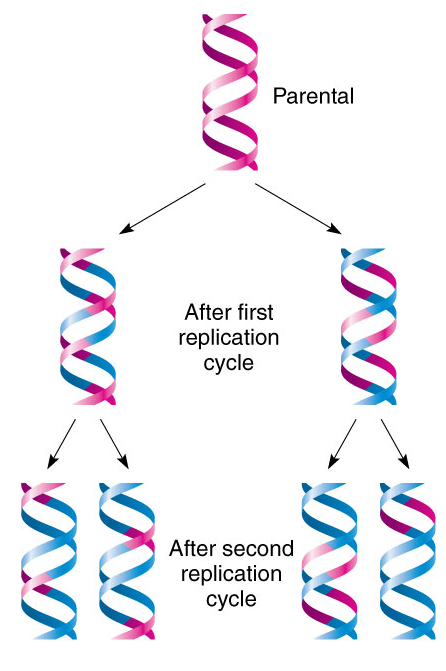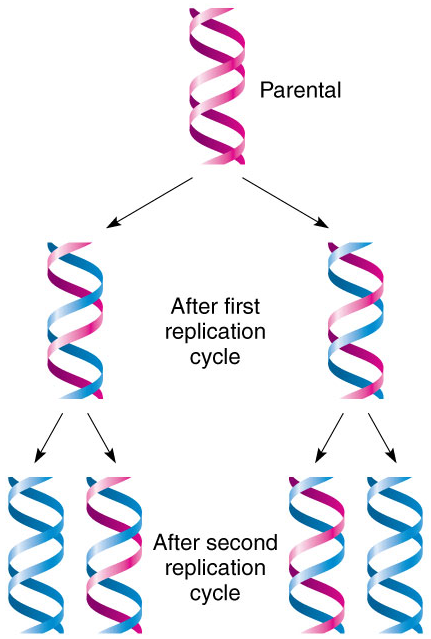The process in which a DNA molecule produces exact copy or replica of itself is known as replication of DNA. In eukaryotes, replication of DNA takes place inside the nucleus.
In DNA replication, the double helix (parent strand) unzips forming two separate strands called templates. These templates provide the base sequences used to synthesize new DNA (daughter) strands. Replication is a very complicated enzyme-catalyzed process. Enzymes are needed to unwind the DNA prior to replication and repackage the DNA after synthesis. There are three hypothesis proposed for replication of DNA
Conservative replication:
In this process, the original helix serves as a template. The original molecule of DNA is preserved and entirely a new double-stranded molecule is synthesized.

Dispersive Replication:
In this hypothesis, it is proposed that the original molecule is broken into fragments. Each fragment serves as a template for the synthesis of complementary fragments and finally, two new molecules are formed which consist of both old and new fragments.

Semiconservative Replication:
This hypothesis was proposed by Watson and Crick on the basis of their model of DNA molecule. They proposed that the DNA molecule untwists and start separating at one end.
During this process, the covalent hydrogen bonds between complementary bases are broken. The separated strands act as a template and using thesis template two new molecules of DNA are synthesized.

Experimental Evidence of Semiconservative Replication of DNA:
- In 1957, Matthew s. Meselson and Franklin W. Stahl confirmed semiconservative replication of DNA experimentally.
- They grew two cultures of E. coli in a medium using ammonium ions (NH4+) as the source of nitrogen for DNA (as well as protein) synthesis.
- One culture was developed on a medium of (NH4+) containing a light isotope (common) of nitrogen 14N and another culture was developed on a medium of (NH4+) containing a heavy isotope (rare) of nitrogen 15N.
- After growing E. coli for several generations in a medium containing 15NH4+, they found that the DNA of the cells was heavier than normal because of the 15N atoms in it.
- The difference could be detected by extracting DNA from the E. coli cells and spinning it in an ultracentrifuge. The density of the DNA determines where it accumulates in the tube.
- Then they transferred more living cells that had been growing in 15NH4+ to a medium containing ordinary ammonium ions (14NH4+) and allowed them to divide just once. The DNA in this new generation of cells was exactly intermediate in density between that of the previous generation and the normal. This could happen with either semi-conservative or dispersive replication. Thus the possibility of conservative replication was eliminated.
- This shows that half the nitrogen atoms in the new DNA are 14N and half are 15N. It tells us nothing about their arrangement in the molecules.
- However, when the bacteria were allowed to divide again in normal ammonium ions (14NH4+), two distinct densities of DNA were formed: a) half the DNA was normal and b) half was intermediate.
- As this experiment was performed for next generations, the density of DNA molecule decreased continuously. i.e. lighter and lighter molecules of DNA are formed. It was continuous decrease and not a random change. This eliminates the possibility of dispersive replication.
- It is evident from the experiment that DNA molecules are not degraded and reformed from free nucleotides between cell divisions, but instead, each original strand remains intact as it builds a complementary strand from the nucleotides available to it.
- Each daughter DNA molecule is one-half “old” and one-half “new”. Hence this replication is called semiconservative replication. It shows that the DNA strand is immortal. it will continue to serve as an unchanging template down through the generations.
Semiconservative Replication of DNA:
Activation of Nucleotides:
All the four types of DNA nucleotides are present in nucleoplasm in the form of their monophosphates. They are activated into triphosphates like dATP, dGTP, dTTP and dCTP using ATP in presence of enzyme called phosphorylase. This process is known as the activation of nucleotides.
dAMP + ATP → dATP + AMP (Enzyme – Phosphorylase)

Origin or initiation Point:
DNA replication starts at certain specific sites situated on the molecule. Such sites are called origin points or initiation points. In eukaryotes, there are several origin points.
During replication, DNA molecules split (unzip) by activity of initiator proteins at the origin by forming an incision also called nick. Here the breaking of the hydrogen bond between two strands of DNA starts.
Unwinding of DNA Strand:
Enzyme DNA Helicase also called rep protein untwists the helix at locations called replication origins.

The replication origin forms a Y-shape and is called a replication fork. The replication fork moves down the DNA strand, usually from an internal location to the strand’s end. Thus every replication fork has a twin replication fork, moving in the opposite direction from that same internal location to the strand’s opposite end. Single-stranded binding proteins (SSB) also called helix destabilizing protein work with helicase to keep the parental DNA helix unwound. It works by coating the unwound strands with rigid subunits of SSB that keep the strands from snapping back together in a helix. The SSB subunits coat the single-strands of DNA in a way as not to cover the bases, allowing the DNA to remain available for base-pairing with the newly synthesized daughter strands.
Synthesis of New Strands:
Each separated strand acts as a template or mould for the synthesis of the complementary new strand. It takes place with the help of RNA molecule called RNA primer. The synthesis of RNA primer is controlled by an enzyme called RNA primase. RNA primer attracts complementary nucleotides from the surrounding nucleoplasm.
When the two parent strands of DNA are separated to begin replication, one strand is oriented in the 5′ to 3′ direction while the other strand is oriented in the 3′ to 5′ direction.
But DNA replication, is inflexible: the enzyme that carries out the replication, DNA polymerase, only functions in the 5′ to 3′ direction. This characteristic of DNA polymerase means that the daughter strands synthesize through two different methods, one adding nucleotides one by one (continuous) in the direction of the replication fork, while the other adds nucleotides only in chunks (non-continuous). The first strand, which replicates nucleotides one by one is called the leading strand; the other strand, which replicates in chunks, is called the lagging strand.

The strand which opens from 3′ to 5′ is called leading template and its complementary strand is called leading strand. It is a continuous and fast process. Triggered by RNA primase, which adds the first nucleotide to the nascent chain, the DNA polymerase simply sits near the replication fork, moving as the fork does, adding nucleotides one after the other, preserving the proper anti-parallel orientation.
The strand which opens from 5′ to 3′ is called lagging template and its complementary strand is called lagging strand. DNA polymerase on the leading strand can simply follow the replication fork, because DNA polymerase must move in the 5′ to 3′ direction, on the lagging strand the enzyme must move away from the fork. But if the enzyme moves away from the fork, and the fork is uncovering new DNA that needs to be replicated. This was explained by Okazaki.

He proposed the formation of the lagging strand is discontinuous and takes place at a slower rate. the fragments of lagging strand formed during formation of complementary strands are called Okazaki fragments. These fragments are then joined by enzyme DNA ligase. Each Okazaki fragment requires an RNA primer. Later RNA primer is removed by the enzyme RNase.
Formation of Daughter DNA Molecules:
For each old strand, a new complementary strand is formed. Simultaneously the two strands undergo coiling and two identical DNA molecules are formed at the end of the process.
As new molecules formed in the replication process retain 50% from parent DNA molecule while remaining 50% is newly formed. Hence the replication is called semi-conservative replication.
Errors of DNA replication and its Repair:
There is a high degree of accuracy in DNA replication. Still, it may have an error of 1 in 1 billion base pairs formed. The initial rate of base pair error is high it is 1 error in 0.1 million base pairs.
But it is immediately corrected by repair enzymes (nucleases) within the DNA polymerase complex. This enzyme proofreads each base pair formed and then remove and replace the mistake in the base pair in coordination with enzyme ligase.
Note:
In Prokaryotes circular DNA is present. There is only one origin and the replication is called theta replication.